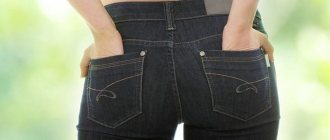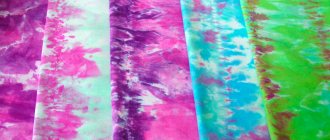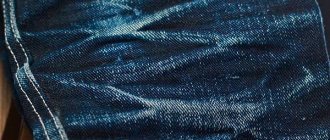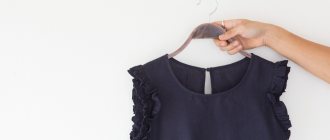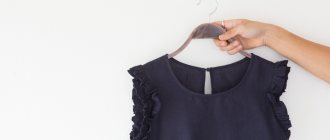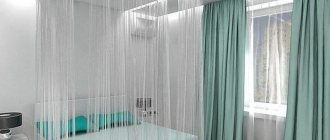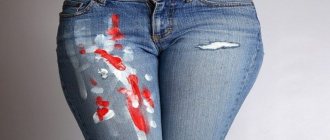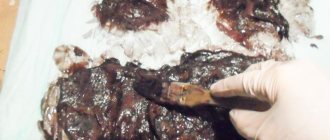Dying can restore your jeans to their former glory. You just need to be careful about the process and follow all the paint manufacturer’s recommendations. And by succumbing to a creative impulse, provided that you have talent and experience in successfully working with artistic brushes, you can become the owner of a completely unique thing. A little luck won’t hurt either - after all, houses are not factory conditions for painting.
- How to increase your chances of success?
- Powder dye
- Is it worth using an automatic car?
- Hand dyeing jeans in an enamel basin
- other methods
How to increase your chances of success?
By choosing a pigment suitable for the fabric and properly preparing the jeans:
- Synthetic fibers are not dyed with substances for cotton and linen. Is there a high percentage of artificial thread in the material of the pants? The new tone will fall unevenly.
- The paint is selected taking into account the maximum permissible temperatures when washing the product. A number of products are designed for use when water is heated to 90 degrees. But at this temperature, some jeans may shrink or stretch 1.5-2 sizes.
Are you unplugging your washing machine?Oh yes! No
- Stripes and logos are pre-stripped - the color of leather or fabric appliqués looks less beautiful after painting.
- Wanting to return jeans to their original attractiveness, they take into account their weight without water. A number of manufacturers produce paints in packaging designed for use on items weighing no more than 500-600 g in dry form.
- Before processing any dye, jeans are cleaned of all types of contaminants. Substances in stains from fat, berries, sauces will interfere with uniform color. In the future, in the problem area, the color of the fabric will be darker or lighter than the rest of the material.
- Washing jeans is a must before restoring their color. To ensure that the conditioner and fiber softeners in the gel or powder do not affect the uniform absorption of coloring pigments in the future, the pants are moistened and rubbed with ordinary household soap or a soap with a whitening effect before washing.
- To evenly distribute the pigment throughout the fabric of already clean and wrung out trousers, soak them for 10-15 minutes in a weak bleach solution based on chlorine-free powder, or in water and anti-stain soap (if this was not done at the washing stage). Before painting, jeans are thoroughly rinsed.
Jeans
How to dye jeans
You can refresh or update the color of denim using synthetic or natural dyes. Let's look at this issue in more detail. Among the chemicals that can stain cotton are:
- Liquid and powder aniline dyes for fabric, for example: “Jeans” series dyes for hand and machine dyeing. Their advantages: color variety, good mixability with each other, low price.
- Powder dyes of varying degrees of stability and intensity, for example: “DYLON”, “Marabu Fashion Color”, “Anles”.
- Blue. The substance can make the color of denim quite uniform and rich, but it will last until the first wash. After using an alkaline cleaning solution, painting will have to be repeated. In addition, the product can only turn jeans that have faded blue.
- Hair dye. Of course, using it for fabric is one of the life hacks. However, high-quality products give good and lasting results.
You can refresh the color of your jeans using natural dyes, for example: herbal infusions, strongly brewed tea and coffee, infused onion peels, and turmeric. But these products penetrate denim fibers very poorly and give, rather, an additional shade rather than a new color, namely:
- turmeric – creamy;
- cinnamon – creamy with pink haze;
- onion peel - sandy;
- tea, oak bark, coffee – brown of varying degrees of intensity.
When choosing a coloring agent, you need to consider:
- How often will the product be washed and exposed to direct sunlight? If jeans are intended for daily wear, it is better to avoid using cheap, unstable dyes.
- What is the weight of the amount of powder in the bag? Perhaps one package will not be enough.
- There is always a danger that the color of the desired saturation will not be obtained the first time, and the procedure will have to be repeated twice. Therefore, you must always have a bag or jar of dye “in reserve.”
When dyeing black fabric, you have to restore the original shade, so only black dye is needed.
Fabric paint
Hardware stores sell fabric dyes. They have a powder structure and are used for painting in the washing machine.
- The powder is mixed with water in the proportion prescribed by the manufacturer.
- The jeans are turning inside out.
- The machine sets the temperature allowed for jeans.
- If the instructions for the paint do not indicate that it requires dilution, then it is poured into the drum onto the jeans that were previously placed there.
- Fabric softener is not added as it may alter the dyeing result.
- The machine is set to a mode for jeans; if it is not there, then a mode is selected, for example, for cotton or linen, at which the water temperature will be 80-90 °C.
- After washing is completed, the jeans are rinsed in cool water with a vinegar solution added to fix the color.
- After rinsing, the jeans are washed again on a short cycle with powder.
- Dry away from heating objects.
Hair dye
It is better to choose a natural dye without ammonia. On average, one pair of jeans takes two packs. The paint is diluted using the usual method according to the manufacturer's recommendations. Clothes are placed in a deep basin and completely filled with warm water in which the prepared paint is diluted. Jeans remain in the dyed mixture for 1.5-2 hours.
After soaking, rinse first in water at room temperature, and then in cold water with vinegar and salt. Then they are washed by machine with the addition of powder and dried in natural conditions.
The rods are removed from several black felt-tip pens and lowered into slightly cold water. When the water turns black, the jeans are immersed in it. After an hour, it is removed from the ink solution, washed with powder and dried.
They help not to re-dye jeans, but to decorate them. Aerosol paints are simply sprayed onto laid out clothes, and an arbitrary image is drawn with acrylics. Paint with a brush or the edge of a washcloth. The image is unique, but uneven. Additionally, you can use a stencil. To fix the acrylic, the jeans are placed between layers of white paper and ironed.
Blue
Sold in powder or solution form at any household. store. Clothes do not require boiling. It is enough to prepare a highly concentrated solution from chilled water, 1-2 tbsp. spoons of salt and blue. The jeans are kept in the solution for 1.5-2 hours; you can soak the clothes overnight. After soaking, rinse in a cold vinegar solution; you can soak for a quarter of an hour.
The blue washes out quickly, so painting will have to be repeated periodically.
Dylon
At the same time it is a denim dye and a detergent. Convenient, economical and easy to use. It is a powder, one package of which is enough to wash and dye half a kilogram of jeans.
When coloring, additional table salt is added to ensure color stability. Instructions for preparing the dye are indicated on the packaging. One packet of paint is enough to prepare a small bucket of solution. First, the powder is diluted in a small amount of water until completely dissolved, and then poured into the bulk.
First, let's figure it out - what's the best way to paint?
- powder paints,
- white,
- blue,
- potassium permanganate,
- acrylic paints,
- aerosols.
The bluing should be diluted with a small amount of water so that the liquid covers the fabric in the basin. Keep for a long time, you can leave it overnight, be sure to turn it over. After this, rinse the excess color well until the water runs clear. Soak, as standard, in vinegar.
This method does not bring a lasting, even, monochromatic result. The color will begin to fade after the first wash. And it will most likely stain your feet.
Enameled dishes, glass, and ceramic are suitable. In principle, at home you can use a bathtub or plastic buckets, but then you will have to wash them for a long time.
We suggest you read: How to preserve horseradish in winter at home
We repeat the same procedure with potassium permanganate. Such partial coloring looks beautiful on light-colored items. The shade depends on the concentration of manganese in the water (from pale pink to dark purple).
Denim is a natural material that can be easily given almost any shade.
Before choosing a method to update the color, you need to decide how to dye your jeans and what products to use.
To update your jeans at home, you can use the following products:
- The most common painting option is blue. This method is very simple, but the result will not last long.
- So-called boiled jeans can be obtained using potassium permanganate. In this case, the result depends on skill and experience, since the process is quite complex.
- You can purchase ready-made aniline dyes. By following the instructions on the package, you can quickly get the desired effect.
- To obtain a more durable result, acrylic paints are suitable.
- Jeans can also be dyed in the washing machine using powder dyes. The painting process is simple, but there is a small selection of shades available.
Blue
Affordable and inexpensive painting options include bluing. But, using this product, it will not be possible to radically change the color of the product; you can only make it blue.
Blue can be purchased at any hardware store.
How to dye jeans blue:
- Dilute the blue in water whose temperature is less than 30 degrees. The brighter the color you want, the more product you need to use. To get a lasting shade, you can add 2 tablespoons of salt to the solution.
- Place the jeans in the solution.
- Leave them for a couple of hours. To ensure uniform painting, the product must be turned over periodically.
- Rinse your pants in cold water.
- To fix the color, rinse them in a weak vinegar solution.
The resulting result will begin to wash off immediately after the first wash, so this method of painting cannot be called optimal.
Powder painting
Painting jeans with powder paints will not harm your washing machine.
Using powdered dye and a washing machine, you can dye your jeans black. To avoid unexpected results, do not add washing powder and fabric softener to the washing machine. Jeans need to be washed first.
How to dye jeans in the washing machine:
- turn the product inside out;
- place the jeans in the washing machine;
- pour coloring powder into the drum;
- set the washing temperature specified on the product label;
- start the standard washing program;
- take out the painted item and rinse in cool water;
- rinse your jeans in a vinegar solution;
- wash them in a washing machine with washing powder;
- dry.
The result of dyeing is a durable, bright color. You should not worry about the washing machine - the use of dye will not affect its functionality in any way. The maximum that can happen is painting the rubber seals. But this problem can easily be solved by wiping them with a damp cloth.
Acrylic paints
Using acrylic paints, you can apply any design to the fabric, which will help hide problem areas and make the item unique and inimitable.
The process will require acrylic paint, brushes of suitable sizes with stiff natural bristles, and an iron. After the design has been applied to the fabric, the product must be ironed from the wrong side.
But this method is short-lived, since after several washes the color of the paint will begin to fade, and may even begin to fade. Therefore, this method is not suitable for everyday items that are often washed.
Is it worth using an automatic car?
Yes. This will not affect the quality of further operation of the machine. For your own peace of mind, after finishing painting, wipe the drum and rubber seal SMA with a light cloth or paper towel.
Expert opinion
Irina. Housewife.
Ask a Question
If suddenly there are traces of pigment on them - this happens very rarely - activate the rinse mode. It is important to consider the weight of the product: when dry, one pair weighs 600-900 grams.
Process steps:
- The dye solution is poured into the drum (powder and laundry conditioner are not added).
- The prepared jeans (clean and rinsed) turned inside out are placed in the machine.
- If indicated in the instructions, pour a portion of ordinary kitchen salt into the drum, which acts as a pigment fixer in the fabric.
- Activate the “cotton” washing mode by selecting a combination with temperature, taking into account the recommendations on the item’s tag.
- The wrung out dyed jeans are immersed for 30 minutes in an acidic solution based on water and vinegar, diluted in a proportion of 1 spoon for every liter of liquid.
- After the fastening procedure, the jeans are washed in a machine, adding the usual portion of powder or gel. The mode chosen is the fastest and most gentle.
- Dry the item in the shade from the sun's rays, hanging it on a rope. We take into account the mass of the wet product.
Blue
How to prepare jeans for blue dyeing
The first and most important tip is that jeans must be absolutely clean before painting. If there are any even minor stains on them, they will not only not be painted over, but will also stand out even more. If it happens that there are stains that cannot be removed, you should choose a paint two shades darker. Paint matched to the tone of the jeans will not cover the stain. Washed jeans should be dry. There is no need to iron them, just keeping them clean is enough.
We recommend reading: Drape coat: how to clean it at home
Hand dyeing jeans in an enamel basin
This processing method is chosen if you want to improve the color of your trousers without subjecting them to harmful mechanical effects, fearing the coloring of the washing machine drum or not having it on hand. It must be said right away that the pigment is not dangerous for the machine - all its particles are washed out with water. But many jeans do not benefit from automatic washing: they begin to stretch, and the color may wash out at the folds of the fabric, which will lead to the formation of streaks on the fabric.
Process steps:
- An enamel basin or bucket is filled with water. Then set the container to heat up.
- The dye is mixed with water and the recommended fixative (salt, soda).
- After the powder has dissolved, the liquid is filtered.
- The mixture is poured into the main volume of water.
- Having put on gloves and clothes for housework, the prepared and turned out jeans are immersed in a container for an hour, making sure that the water boils gently throughout the entire period. The item is systematically carefully turned over.
- The painted product is transferred to a container with warm water, and then cold.
- After rinsing the cooled jeans, the color is fixed by immersing them for 30 minutes in a vinegar solution (formula: per liter of water, a tablespoon of 9% product).
- The product is washed again as usual.
- Dry the item in partial shade, away from heating devices.
veronika_makarova88
jeans_style_boutique
x_jeans22
the_best_choice_ua
other methods
Creative people are not able to neglect informal color options for their favorite jeans, so ancient and newly invented methods are used.
Blue
This product is usually used to enhance the attractiveness of white items. But if you play with the concentration of the coloring solution, then as a result it can give the thing a pleasant, rich blue tint. In this way, the degree of bluing can be adjusted.
True, the resulting color has a short lifespan: after washing, the color of the jeans will be one step closer to what it was before the procedure. Over a series of cycles, it is restored.
Process steps:
- The coloring liquid is poured into lukewarm water. The more intense the color of the solution, the deeper the shade.
- To make the paint stick better to the fabric, the same water is turned into “sea water” with 3-4 tablespoons of table salt.
- Jeans are immersed in the solution for 4 hours. Uniform color distribution is achieved by frequently turning the item over.
- Rinse it in acidic water, adding a spoonful of vinegar for each liter.
Hair dye
Hair dye
To understand how acceptable this method is for dyeing coarse fabrics, it is advisable to carry out the first attempt on “denim”, which has already seen its fair share of wear and tear and can then be thrown into the trash without much mental anguish.
Steps in the process of applying hair dye:
- The product is washed and rinsed.
- Four portions of dye, previously thoroughly diluted to a liquid state, are dissolved in 7-8 liters of moderately hot water.
- Dip the product into the solution and leave it to soak for an hour and a half to two hours. Periodically squash the jeans in the water and turn them over.
- At the end of the allotted time, the “denim” is soaked in an acidic medium with the addition of salt - a spoonful of each component (the second is 6-9% vinegar) per liter of water.
- After all the manipulations, the item is washed in a delicate mode using a small amount of gel or powder.
Are you using citric acid?
Oh yes! No
How to use aerosol sprays?
There is no need to completely paint over the fabric on the trousers with spray paint - it is better to use it to create color accents by dividing the entire surface of the product into sectors or highlighting individual areas using a stencil.
Technology:
- Thinking through the design.
- Prepare the trousers (get rid of stains, wash, dry thoroughly and iron).
- For sectorial application of paint or when using a stencil, cover untreated areas with paper.
- The painted elements are allowed to dry thoroughly, following the product manufacturer's recommendations.
